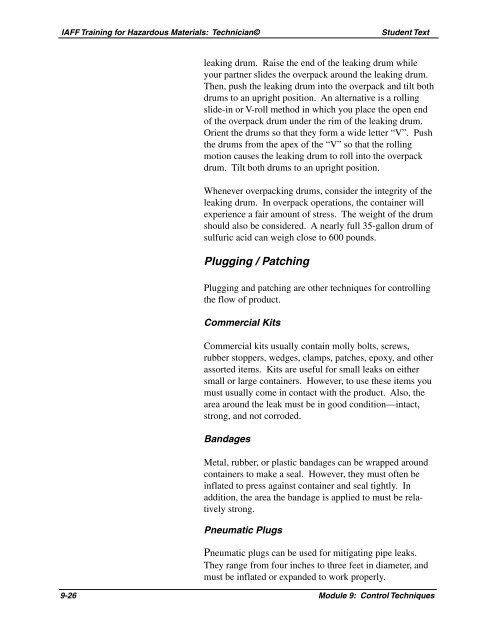Module 9: Control Techniques - International Association of Fire ...
Module 9: Control Techniques - International Association of Fire ...
Module 9: Control Techniques - International Association of Fire ...
You also want an ePaper? Increase the reach of your titles
YUMPU automatically turns print PDFs into web optimized ePapers that Google loves.
IAFF Training for Hazardous Materials: Technician©<br />
Student Text<br />
leaking drum. Raise the end <strong>of</strong> the leaking drum while<br />
your partner slides the overpack around the leaking drum.<br />
Then, push the leaking drum into the overpack and tilt both<br />
drums to an upright position. An alternative is a rolling<br />
slide-in or V-roll method in which you place the open end<br />
<strong>of</strong> the overpack drum under the rim <strong>of</strong> the leaking drum.<br />
Orient the drums so that they form a wide letter “V”. Push<br />
the drums from the apex <strong>of</strong> the “V” so that the rolling<br />
motion causes the leaking drum to roll into the overpack<br />
drum. Tilt both drums to an upright position.<br />
Whenever overpacking drums, consider the integrity <strong>of</strong> the<br />
leaking drum. In overpack operations, the container will<br />
experience a fair amount <strong>of</strong> stress. The weight <strong>of</strong> the drum<br />
should also be considered. A nearly full 35-gallon drum <strong>of</strong><br />
sulfuric acid can weigh close to 600 pounds.<br />
Plugging / Patching<br />
Plugging and patching are other techniques for controlling<br />
the flow <strong>of</strong> product.<br />
Commercial Kits<br />
Commercial kits usually contain molly bolts, screws,<br />
rubber stoppers, wedges, clamps, patches, epoxy, and other<br />
assorted items. Kits are useful for small leaks on either<br />
small or large containers. However, to use these items you<br />
must usually come in contact with the product. Also, the<br />
area around the leak must be in good condition—intact,<br />
strong, and not corroded.<br />
Bandages<br />
Metal, rubber, or plastic bandages can be wrapped around<br />
containers to make a seal. However, they must <strong>of</strong>ten be<br />
inflated to press against container and seal tightly. In<br />
addition, the area the bandage is applied to must be relatively<br />
strong.<br />
Pneumatic Plugs<br />
Pneumatic plugs can be used for mitigating pipe leaks.<br />
They range from four inches to three feet in diameter, and<br />
must be inflated or expanded to work properly.<br />
9-26 <strong>Module</strong> 9: <strong>Control</strong> <strong>Techniques</strong>
















